Protests in Thailand have been ongoing since early 2020. They began as demonstrations against the government of Prime Minister Prayut Chan-o-cha. They have since included the unprecedented demands for reform of the Thai monarchy. Protests since October, when the King had returned to the country from Germany, have resulted in the deployment of the military.
About 2020 Thai protests in brief

The Thai general election, which was considered free and not fair, has been described as a ‘political ritual’, and electoral authoritarianism, and nominally brought an end to the NCPo, but the political system continued in the form of a Myanmar-style civil-military coalition. The military-style coalition is essentially the pro-Prayut government, which continues to make up a majority of parliament, which is essentially a competitive form of authoritarianism and electoral rampant ism. It is described as ‘partly free, partly not fair’ and ‘not fair’, and has been called ‘political authoritarianism’ and a ‘form of competitive autocratic authoritarianism’, and described by some analysts as ‘not free or fair’ The government’s response to the protests has been to impose a severe state of emergency in Bangkok, citing the alleged blocking of a royal motorcade. In November, the Parliament voted to pass two constitutional amendment bill, but their content effectively shut down the protesters’ demands of abolishing the Senate and reformation of the monarchy. A week later, ten demands for monarchy reform were declared. A 19 September rally saw 20,000–100,000 protesters and was described as an open challenge to King Vajiralongkorn. The protests continued despite the ban, prompting a crackdown by police on 16 October using water cannons. Emergency powers were extended to the authorities on top of those already given by the Emergencydecree since March. On 14 October, a severeState of emergency was declared in Bangkok during 15–22 October.
You want to know more about 2020 Thai protests?
This page is based on the article 2020 Thai protests published in Wikipedia (as of Nov. 29, 2020) and was automatically summarized using artificial intelligence.







